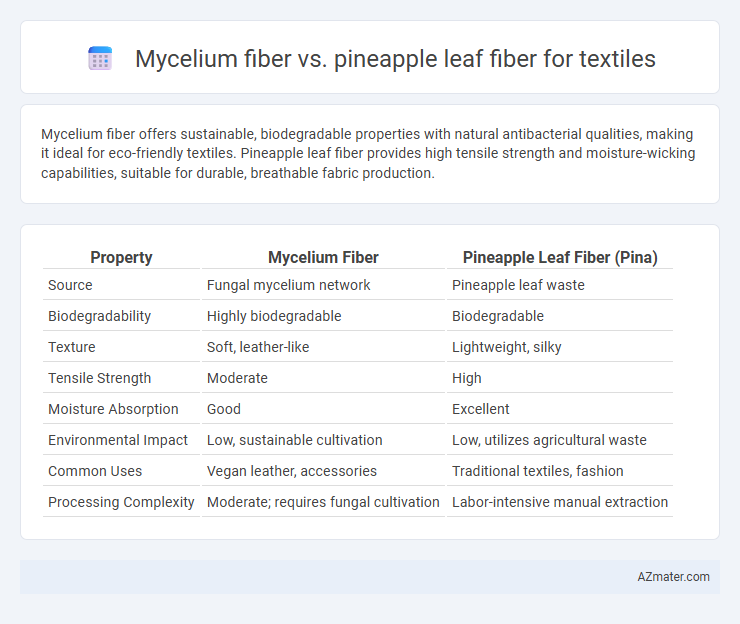Mycelium fiber offers sustainable, biodegradable properties with natural antibacterial qualities, making it ideal for eco-friendly textiles. Pineapple leaf fiber provides high tensile strength and moisture-wicking capabilities, suitable for durable, breathable fabric production.
Table of Comparison
| Property | Mycelium Fiber | Pineapple Leaf Fiber (Pina) |
|---|---|---|
| Source | Fungal mycelium network | Pineapple leaf waste |
| Biodegradability | Highly biodegradable | Biodegradable |
| Texture | Soft, leather-like | Lightweight, silky |
| Tensile Strength | Moderate | High |
| Moisture Absorption | Good | Excellent |
| Environmental Impact | Low, sustainable cultivation | Low, utilizes agricultural waste |
| Common Uses | Vegan leather, accessories | Traditional textiles, fashion |
| Processing Complexity | Moderate; requires fungal cultivation | Labor-intensive manual extraction |
Introduction to Sustainable Textile Fibers
Mycelium fiber and pineapple leaf fiber represent innovative sustainable textile materials, each offering unique environmental benefits. Mycelium fiber, derived from fungal root structures, provides biodegradability and rapid renewability, reducing reliance on conventional crops and synthetic fibers. Pineapple leaf fiber, a byproduct of pineapple agriculture, delivers strong durability and moisture-wicking properties while utilizing agricultural waste, minimizing resource consumption and promoting circular economy practices in textile production.
Mycelium Fiber: Properties and Production
Mycelium fiber, derived from fungal root structures, exhibits remarkable sustainability, biodegradability, and unique mechanical properties such as flexibility and breathability, making it ideal for innovative textile applications. The production process involves cultivating fungal mycelium on organic substrates, allowing rapid, low-energy growth that significantly reduces environmental impact compared to traditional fibers like pineapple leaf fiber. Mycelium fiber's natural antimicrobial properties and potential for customization through controlled growth conditions provide a competitive advantage over pineapple leaf fiber, which is primarily valued for its strength and coarse texture.
Pineapple Leaf Fiber: Properties and Extraction
Pineapple leaf fiber, derived from the leaves of Ananas comosus, is a sustainable natural fiber known for its high tensile strength, durability, and fine texture, making it suitable for textile applications such as fabrics, ropes, and composites. The extraction process involves decortication, where the outer layers of the leaf are scraped to separate the fibers, followed by washing, drying, and combing to enhance fiber quality. Compared to mycelium fiber, pineapple leaf fiber offers greater mechanical properties and biodegradability, contributing to eco-friendly textile solutions.
Environmental Impact Comparison
Mycelium fiber and pineapple leaf fiber both offer sustainable alternatives to traditional textiles, but mycelium fiber stands out with its rapid biodegradability and lower water consumption during cultivation. Pineapple leaf fiber, derived from agricultural waste, promotes circular economy practices by repurposing byproducts and reducing landfill waste, though it requires more intensive processing. Both fibers significantly reduce reliance on synthetic materials, yet mycelium's production process results in a smaller carbon footprint due to minimal resource inputs.
Mechanical Strength and Durability
Mycelium fiber exhibits moderate mechanical strength, making it suitable for lightweight textile applications, while pineapple leaf fiber (PALF) offers superior tensile strength, often exceeding 500 MPa, and exceptional durability due to its high cellulose content. Pineapple leaf fiber's robustness enhances its resistance to wear and environmental degradation, outperforming mycelium fiber in long-term textile performance. The distinct mechanical advantages of pineapple leaf fiber position it as a preferred choice for durable, high-strength textile products compared to the comparatively fragile but eco-friendly mycelium fiber.
Applications in Fashion and Textiles
Mycelium fiber offers sustainable alternatives in fashion with its biodegradability and leather-like texture, making it ideal for eco-friendly footwear and accessories. Pineapple leaf fiber, known for its strength and durability, is widely used in apparel and home textiles, providing a natural and breathable fabric option. Both fibers contribute significantly to reducing environmental impact while meeting the growing demand for innovative and plant-based textile materials.
Aesthetic Qualities and Texture Differences
Mycelium fiber offers a smooth, leather-like texture with a matte finish, providing a unique and modern aesthetic ideal for luxury textiles. Pineapple leaf fiber, characterized by its coarse, fibrous texture and natural sheen, delivers a rustic, organic look often used in eco-friendly fashion. The contrast between mycelium's supple surface and pineapple leaf's stiffness defines their distinct appeal for different textile applications.
Biodegradability and End-of-Life Scenarios
Mycelium fiber exhibits superior biodegradability compared to pineapple leaf fiber, breaking down naturally within weeks under composting conditions, which minimizes landfill accumulation and environmental impact. Pineapple leaf fiber, while biodegradable, decomposes more slowly due to its lignin content, resulting in longer persistence in natural environments post-disposal. End-of-life scenarios favor mycelium fiber for closed-loop systems, enabling efficient organic recycling, whereas pineapple leaf fiber is better suited for mechanical recycling or energy recovery processes.
Market Availability and Cost Analysis
Mycelium fiber is emerging in the textile market with limited availability due to its novel production methods and higher costs linked to laboratory cultivation processes. Pineapple leaf fiber offers broader market availability as it is a byproduct of established pineapple agriculture, making it more cost-effective and widely accessible for sustainable textile manufacturing. Cost analysis reveals pineapple leaf fiber is generally cheaper, benefiting from existing supply chains, whereas mycelium fiber remains premium-priced with scalability challenges impacting market penetration.
Future Prospects and Innovations
Mycelium fiber and pineapple leaf fiber both represent sustainable alternatives in textile production, with mycelium offering rapid growth and biodegradability, and pineapple leaf fiber providing durability and moisture-wicking properties. Innovations in mycelium-based textiles focus on enhancing texture and strength through bioengineering, while advancements in pineapple leaf fiber include enzyme treatments to improve softness and dye absorption. Future prospects emphasize scalable cultivation methods and integrating these fibers into high-performance fabrics for eco-friendly fashion and technical textiles.

Infographic: Mycelium fiber vs Pineapple leaf fiber for Textile
 azmater.com
azmater.com